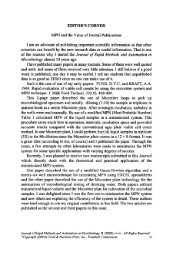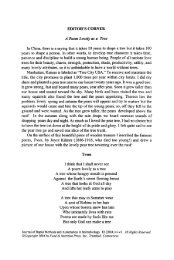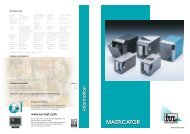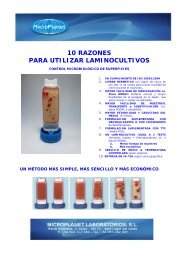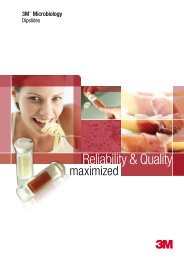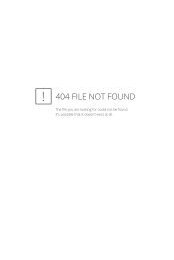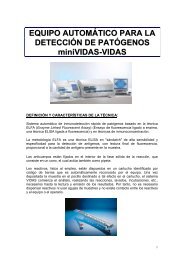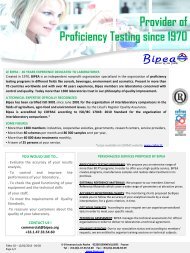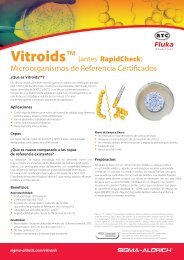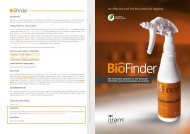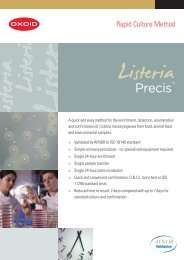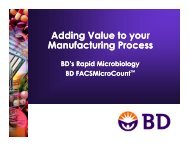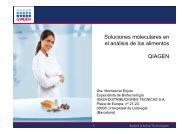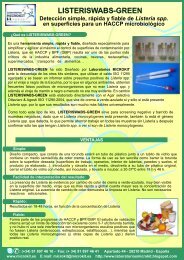BD FACSMicroCount?
BD FACSMicroCount?
BD FACSMicroCount?
Create successful ePaper yourself
Turn your PDF publications into a flip-book with our unique Google optimized e-Paper software.
Solutions for:<br />
Finished Product and Raw Material Screening for Bioburden<br />
Stock Culture Enumeration<br />
Monitoring Microbial Fermentation<br />
Purified and Process Water Total Viable Organism Screening<br />
Microbial Enumeration for Probiotic Manufacturing<br />
• Microbial enumeration in 4 minutes<br />
• Pass / Fail results for presence / absence of microbial contamination in 24 to 48 hours<br />
• Yeast, bacteria and mold detection in a single run<br />
• 20 samples per hour for qualitative analysis (presence / absence)<br />
• Up to 15 samples per hour for quantitative analysis (enumeration)<br />
• Several reagents for enumeration of live cells, dead cells or total biomass<br />
• Graphical displays include intensity, fluorescence, side scatter and counts vs. time<br />
• Data analysis possible while the system processes other samples<br />
<strong>BD</strong> Diagnostics<br />
7 Loveton Circle<br />
Sparks, MD 21152-0999<br />
800.638.8663<br />
www.bd.com/ds<br />
2100 Derry Road West<br />
Suite 100<br />
Mississauga, Ontario<br />
Canada L5N 0B3<br />
Tel: 800.268.5430<br />
Monte Pelvoux 111, 9 th Floor<br />
Col. Lomas de Chapultepec<br />
11000 México D.F.<br />
Tel: 52.55.59.99.82.00<br />
Tullastrasse 8-12<br />
69126 Heidelberg, Germany<br />
Tel: 49.6221.305.0<br />
Akasaka Garden City<br />
15-1 Akasaka 4-chome<br />
Minato-ku<br />
Tokyo, 107 Japan<br />
Tel: 81.24.593.5405<br />
30/F Citic Square<br />
1168 Nan Jing Road (w)<br />
Shanghai, 200041 China<br />
Tel: 86.21.3210.4610<br />
Rua Alexandre Dumas 1976<br />
04717-004 São Paulo, S.P. Brazil<br />
Tel: 55.11.0800.055.5654<br />
tomer<br />
<strong>BD</strong>, <strong>BD</strong> Logo and all other trademarks are property of Becton, Dickinson and Company. ©2011 <strong>BD</strong><br />
223497 September 2011 Printed in U.S.A.<br />
Rapid<br />
<strong>BD</strong> <strong>FACSMicroCount</strong> <br />
Microbiology – it’s what we do<br />
Confidence in microbial testing<br />
solutions to save you time.<br />
Time is money.
Rapid Detection of Bacteria, Yeasts and Molds<br />
Versatile and easy to use to save you time<br />
• Easy to use with automated sample enumeration and screening, requiring<br />
minimal training<br />
• Easy to validate with traditional methods<br />
• Highly versatile with the ability to run various sample types<br />
<strong>BD</strong> <strong>FACSMicroCount</strong> System<br />
Flow-cytometry based solution for rapid bioburden<br />
testing and rapid enumeration of microbes<br />
Use the <strong>BD</strong> <strong>FACSMicroCount</strong> for:<br />
Product Release Validation Meet regulatory requirements;<br />
direct correlation with traditional methods<br />
In-Process Quality Earlier bioburden results allow early intervention<br />
and reduce risk of compromising future product<br />
Convenience Multiple sample types and test protocols run simultaneously<br />
Operational Cost Savings Reduce inventory-related costs<br />
Labor Cost Reduction Easy to use workflow and walk-away automation<br />
enables flexibility of resources<br />
KNOW that your product contains the following<br />
microorganisms with the <strong>BD</strong> <strong>FACSMicroCount</strong> System:<br />
• Gram-positive bacteria<br />
• Gram-negative bacteria<br />
• Mycoplasmas<br />
• Spirochetes<br />
• Anaerobes<br />
• Spores – bacterial and mold<br />
• Filamentous bacteria, yeasts, and molds<br />
Fully Automated System: How it Works How it Works<br />
A<br />
5<br />
8<br />
7<br />
3<br />
2<br />
B<br />
A to D<br />
1 to 8<br />
<strong>BD</strong> flow cytometers are Class I (1) laser products.<br />
2<br />
1<br />
6<br />
2<br />
4<br />
Area used on system<br />
Procedure<br />
D<br />
B<br />
1<br />
2<br />
3<br />
4<br />
5<br />
6<br />
7<br />
VIALS<br />
• 3 mL sample in each vial<br />
• 42 samples can be loaded at a time<br />
SAMPLE TRAYS<br />
• 3 Sample Trays for 12 samples each<br />
• Magnetized for automatic detection when<br />
loaded in system<br />
• Can be pulled out and loaded in the middle<br />
of a run to keep test going<br />
PRIORITY TRAY<br />
• Holds 6 samples<br />
• Takes precedence over other samples if<br />
introduced in the middle of a run<br />
ROBOTIC ARM<br />
• Enables Sample Gripper to move vials and<br />
syringes to desired ports<br />
REAGENT DISPENSER<br />
• Up to 3 reagents dispensed<br />
• Microbes are labeled with nucleic acid dye<br />
to fluoresce<br />
VORTEXER<br />
• Mixes sample with injected reagent<br />
• Vortexed sample incubated in Sample Tray<br />
SYRINGES<br />
• Draws 1 mL aliquot from sample<br />
8 SAMPLE INJECTION PORT<br />
• Between 0.1 mL – 0.5 mL sample is injected<br />
into this port for flow-cytometry based<br />
detection<br />
FLOW CELL<br />
• Hydrodynamic focusing guides microbes<br />
in single file stream<br />
• Laser beam causes fluorescence<br />
• Optics system collects fluorescence<br />
and side-scatter information to confirm<br />
microbial contamination<br />
A<br />
C<br />
C<br />
DATA ANALYSIS<br />
(is presented in tabular and<br />
graphical format)<br />
TABULAR FORMAT<br />
• Can be reviewed while other<br />
samples are being processed<br />
• Pass / Fail criteria can be<br />
specified to provide visual<br />
highlights (green for pass,<br />
red for fail, etc.)<br />
DATA ANALYSIS<br />
GRAPHICAL FORMAT<br />
• Can be reviewed while other<br />
samples are being processed<br />
• Detection of bacteria, yeasts<br />
and molds possible in the same<br />
run for product screening<br />
• Total Viable Organism (TVO)<br />
count can be provided for<br />
specific samples<br />
OWN METHOD CREATION<br />
3 reagent ports to dispense<br />
up to 3 reagents based on<br />
defined method<br />
STEP 1 Prepare sample for analysis using 10 4 – 10 5 cfu / mL<br />
concentration<br />
STEP 2 Create a new method file using Utilities and Methods links<br />
STEP 3 Set new method parameters including Sample Volume,<br />
Counting Algorithm, and Results Criteria on intuitive screen<br />
STEP 4 Define up to 3 areas of interest (e.g. mold, bacteria and<br />
yeast) per method<br />
STEP 5 Define up to 3 reagents per method<br />
EXISTING METHOD OPTIMIZATION<br />
STEP 1 Use Utilities and Methods links to select desired method<br />
STEP 2 Use Area Definitions tab to add or modify new or existing<br />
area definitions through click and drag operations<br />
STEP 3 Use Settings tab to modify results criteria<br />
D
Rapid Detection of Bacteria, Yeasts and Molds<br />
Versatile and easy to use to save you time<br />
• Easy to use with automated sample enumeration and screening, requiring<br />
minimal training<br />
• Easy to validate with traditional methods<br />
• Highly versatile with the ability to run various sample types<br />
<strong>BD</strong> <strong>FACSMicroCount</strong> System<br />
Flow-cytometry based solution for rapid bioburden<br />
testing and rapid enumeration of microbes<br />
Use the <strong>BD</strong> <strong>FACSMicroCount</strong> for:<br />
Product Release Validation Meet regulatory requirements;<br />
direct correlation with traditional methods<br />
In-Process Quality Earlier bioburden results allow early intervention<br />
and reduce risk of compromising future product<br />
Convenience Multiple sample types and test protocols run simultaneously<br />
Operational Cost Savings Reduce inventory-related costs<br />
Labor Cost Reduction Easy to use workflow and walk-away automation<br />
enables flexibility of resources<br />
KNOW that your product contains the following<br />
microorganisms with the <strong>BD</strong> <strong>FACSMicroCount</strong> System:<br />
• Gram-positive bacteria<br />
• Gram-negative bacteria<br />
• Mycoplasmas<br />
• Spirochetes<br />
• Anaerobes<br />
• Spores – bacterial and mold<br />
• Filamentous bacteria, yeasts, and molds<br />
Fully Automated System: How it Works How it Works<br />
A<br />
5<br />
8<br />
7<br />
3<br />
2<br />
B<br />
A to D<br />
1 to 8<br />
<strong>BD</strong> flow cytometers are Class I (1) laser products.<br />
2<br />
1<br />
6<br />
2<br />
4<br />
Area used on system<br />
Procedure<br />
D<br />
B<br />
1<br />
2<br />
3<br />
4<br />
5<br />
6<br />
7<br />
VIALS<br />
• 3 mL sample in each vial<br />
• 42 samples can be loaded at a time<br />
SAMPLE TRAYS<br />
• 3 Sample Trays for 12 samples each<br />
• Magnetized for automatic detection when<br />
loaded in system<br />
• Can be pulled out and loaded in the middle<br />
of a run to keep test going<br />
PRIORITY TRAY<br />
• Holds 6 samples<br />
• Takes precedence over other samples if<br />
introduced in the middle of a run<br />
ROBOTIC ARM<br />
• Enables Sample Gripper to move vials and<br />
syringes to desired ports<br />
REAGENT DISPENSER<br />
• Up to 3 reagents dispensed<br />
• Microbes are labeled with nucleic acid dye<br />
to fluoresce<br />
VORTEXER<br />
• Mixes sample with injected reagent<br />
• Vortexed sample incubated in Sample Tray<br />
SYRINGES<br />
• Draws 1 mL aliquot from sample<br />
8 SAMPLE INJECTION PORT<br />
• Between 0.1 mL – 0.5 mL sample is injected<br />
into this port for flow-cytometry based<br />
detection<br />
FLOW CELL<br />
• Hydrodynamic focusing guides microbes<br />
in single file stream<br />
• Laser beam causes fluorescence<br />
• Optics system collects fluorescence<br />
and side-scatter information to confirm<br />
microbial contamination<br />
A<br />
C<br />
C<br />
DATA ANALYSIS<br />
(is presented in tabular and<br />
graphical format)<br />
TABULAR FORMAT<br />
• Can be reviewed while other<br />
samples are being processed<br />
• Pass / Fail criteria can be<br />
specified to provide visual<br />
highlights (green for pass,<br />
red for fail, etc.)<br />
DATA ANALYSIS<br />
GRAPHICAL FORMAT<br />
• Can be reviewed while other<br />
samples are being processed<br />
• Detection of bacteria, yeasts<br />
and molds possible in the same<br />
run for product screening<br />
• Total Viable Organism (TVO)<br />
count can be provided for<br />
specific samples<br />
OWN METHOD CREATION<br />
3 reagent ports to dispense<br />
up to 3 reagents based on<br />
defined method<br />
STEP 1 Prepare sample for analysis using 10 4 – 10 5 cfu / mL<br />
concentration<br />
STEP 2 Create a new method file using Utilities and Methods links<br />
STEP 3 Set new method parameters including Sample Volume,<br />
Counting Algorithm, and Results Criteria on intuitive screen<br />
STEP 4 Define up to 3 areas of interest (e.g. mold, bacteria and<br />
yeast) per method<br />
STEP 5 Define up to 3 reagents per method<br />
EXISTING METHOD OPTIMIZATION<br />
STEP 1 Use Utilities and Methods links to select desired method<br />
STEP 2 Use Area Definitions tab to add or modify new or existing<br />
area definitions through click and drag operations<br />
STEP 3 Use Settings tab to modify results criteria<br />
D
Rapid Detection of Bacteria, Yeasts and Molds<br />
Versatile and easy to use to save you time<br />
• Easy to use with automated sample enumeration and screening, requiring<br />
minimal training<br />
• Easy to validate with traditional methods<br />
• Highly versatile with the ability to run various sample types<br />
<strong>BD</strong> <strong>FACSMicroCount</strong> System<br />
Flow-cytometry based solution for rapid bioburden<br />
testing and rapid enumeration of microbes<br />
Use the <strong>BD</strong> <strong>FACSMicroCount</strong> for:<br />
Product Release Validation Meet regulatory requirements;<br />
direct correlation with traditional methods<br />
In-Process Quality Earlier bioburden results allow early intervention<br />
and reduce risk of compromising future product<br />
Convenience Multiple sample types and test protocols run simultaneously<br />
Operational Cost Savings Reduce inventory-related costs<br />
Labor Cost Reduction Easy to use workflow and walk-away automation<br />
enables flexibility of resources<br />
KNOW that your product contains the following<br />
microorganisms with the <strong>BD</strong> <strong>FACSMicroCount</strong> System:<br />
• Gram-positive bacteria<br />
• Gram-negative bacteria<br />
• Mycoplasmas<br />
• Spirochetes<br />
• Anaerobes<br />
• Spores – bacterial and mold<br />
• Filamentous bacteria, yeasts, and molds<br />
Fully Automated System: How it Works How it Works<br />
A<br />
5<br />
8<br />
7<br />
3<br />
2<br />
B<br />
A to D<br />
1 to 8<br />
<strong>BD</strong> flow cytometers are Class I (1) laser products.<br />
2<br />
1<br />
6<br />
2<br />
4<br />
Area used on system<br />
Procedure<br />
D<br />
B<br />
1<br />
2<br />
3<br />
4<br />
5<br />
6<br />
7<br />
VIALS<br />
• 3 mL sample in each vial<br />
• 42 samples can be loaded at a time<br />
SAMPLE TRAYS<br />
• 3 Sample Trays for 12 samples each<br />
• Magnetized for automatic detection when<br />
loaded in system<br />
• Can be pulled out and loaded in the middle<br />
of a run to keep test going<br />
PRIORITY TRAY<br />
• Holds 6 samples<br />
• Takes precedence over other samples if<br />
introduced in the middle of a run<br />
ROBOTIC ARM<br />
• Enables Sample Gripper to move vials and<br />
syringes to desired ports<br />
REAGENT DISPENSER<br />
• Up to 3 reagents dispensed<br />
• Microbes are labeled with nucleic acid dye<br />
to fluoresce<br />
VORTEXER<br />
• Mixes sample with injected reagent<br />
• Vortexed sample incubated in Sample Tray<br />
SYRINGES<br />
• Draws 1 mL aliquot from sample<br />
8 SAMPLE INJECTION PORT<br />
• Between 0.1 mL – 0.5 mL sample is injected<br />
into this port for flow-cytometry based<br />
detection<br />
FLOW CELL<br />
• Hydrodynamic focusing guides microbes<br />
in single file stream<br />
• Laser beam causes fluorescence<br />
• Optics system collects fluorescence<br />
and side-scatter information to confirm<br />
microbial contamination<br />
A<br />
C<br />
C<br />
DATA ANALYSIS<br />
(is presented in tabular and<br />
graphical format)<br />
TABULAR FORMAT<br />
• Can be reviewed while other<br />
samples are being processed<br />
• Pass / Fail criteria can be<br />
specified to provide visual<br />
highlights (green for pass,<br />
red for fail, etc.)<br />
DATA ANALYSIS<br />
GRAPHICAL FORMAT<br />
• Can be reviewed while other<br />
samples are being processed<br />
• Detection of bacteria, yeasts<br />
and molds possible in the same<br />
run for product screening<br />
• Total Viable Organism (TVO)<br />
count can be provided for<br />
specific samples<br />
OWN METHOD CREATION<br />
3 reagent ports to dispense<br />
up to 3 reagents based on<br />
defined method<br />
STEP 1 Prepare sample for analysis using 10 4 – 10 5 cfu / mL<br />
concentration<br />
STEP 2 Create a new method file using Utilities and Methods links<br />
STEP 3 Set new method parameters including Sample Volume,<br />
Counting Algorithm, and Results Criteria on intuitive screen<br />
STEP 4 Define up to 3 areas of interest (e.g. mold, bacteria and<br />
yeast) per method<br />
STEP 5 Define up to 3 reagents per method<br />
EXISTING METHOD OPTIMIZATION<br />
STEP 1 Use Utilities and Methods links to select desired method<br />
STEP 2 Use Area Definitions tab to add or modify new or existing<br />
area definitions through click and drag operations<br />
STEP 3 Use Settings tab to modify results criteria<br />
D
Rapid Detection of Bacteria, Yeasts and Molds<br />
Versatile and easy to use to save you time<br />
• Easy to use with automated sample enumeration and screening, requiring<br />
minimal training<br />
• Easy to validate with traditional methods<br />
• Highly versatile with the ability to run various sample types<br />
<strong>BD</strong> <strong>FACSMicroCount</strong> System<br />
Flow-cytometry based solution for rapid bioburden<br />
testing and rapid enumeration of microbes<br />
Use the <strong>BD</strong> <strong>FACSMicroCount</strong> for:<br />
Product Release Validation Meet regulatory requirements;<br />
direct correlation with traditional methods<br />
In-Process Quality Earlier bioburden results allow early intervention<br />
and reduce risk of compromising future product<br />
Convenience Multiple sample types and test protocols run simultaneously<br />
Operational Cost Savings Reduce inventory-related costs<br />
Labor Cost Reduction Easy to use workflow and walk-away automation<br />
enables flexibility of resources<br />
KNOW that your product contains the following<br />
microorganisms with the <strong>BD</strong> <strong>FACSMicroCount</strong> System:<br />
• Gram-positive bacteria<br />
• Gram-negative bacteria<br />
• Mycoplasmas<br />
• Spirochetes<br />
• Anaerobes<br />
• Spores – bacterial and mold<br />
• Filamentous bacteria, yeasts, and molds<br />
Fully Automated System: How it Works How it Works<br />
A<br />
5<br />
8<br />
7<br />
3<br />
2<br />
B<br />
A to D<br />
1 to 8<br />
<strong>BD</strong> flow cytometers are Class I (1) laser products.<br />
2<br />
1<br />
6<br />
2<br />
4<br />
Area used on system<br />
Procedure<br />
D<br />
B<br />
1<br />
2<br />
3<br />
4<br />
5<br />
6<br />
7<br />
VIALS<br />
• 3 mL sample in each vial<br />
• 42 samples can be loaded at a time<br />
SAMPLE TRAYS<br />
• 3 Sample Trays for 12 samples each<br />
• Magnetized for automatic detection when<br />
loaded in system<br />
• Can be pulled out and loaded in the middle<br />
of a run to keep test going<br />
PRIORITY TRAY<br />
• Holds 6 samples<br />
• Takes precedence over other samples if<br />
introduced in the middle of a run<br />
ROBOTIC ARM<br />
• Enables Sample Gripper to move vials and<br />
syringes to desired ports<br />
REAGENT DISPENSER<br />
• Up to 3 reagents dispensed<br />
• Microbes are labeled with nucleic acid dye<br />
to fluoresce<br />
VORTEXER<br />
• Mixes sample with injected reagent<br />
• Vortexed sample incubated in Sample Tray<br />
SYRINGES<br />
• Draws 1 mL aliquot from sample<br />
8 SAMPLE INJECTION PORT<br />
• Between 0.1 mL – 0.5 mL sample is injected<br />
into this port for flow-cytometry based<br />
detection<br />
FLOW CELL<br />
• Hydrodynamic focusing guides microbes<br />
in single file stream<br />
• Laser beam causes fluorescence<br />
• Optics system collects fluorescence<br />
and side-scatter information to confirm<br />
microbial contamination<br />
A<br />
C<br />
C<br />
DATA ANALYSIS<br />
(is presented in tabular and<br />
graphical format)<br />
TABULAR FORMAT<br />
• Can be reviewed while other<br />
samples are being processed<br />
• Pass / Fail criteria can be<br />
specified to provide visual<br />
highlights (green for pass,<br />
red for fail, etc.)<br />
DATA ANALYSIS<br />
GRAPHICAL FORMAT<br />
• Can be reviewed while other<br />
samples are being processed<br />
• Detection of bacteria, yeasts<br />
and molds possible in the same<br />
run for product screening<br />
• Total Viable Organism (TVO)<br />
count can be provided for<br />
specific samples<br />
OWN METHOD CREATION<br />
3 reagent ports to dispense<br />
up to 3 reagents based on<br />
defined method<br />
STEP 1 Prepare sample for analysis using 10 4 – 10 5 cfu / mL<br />
concentration<br />
STEP 2 Create a new method file using Utilities and Methods links<br />
STEP 3 Set new method parameters including Sample Volume,<br />
Counting Algorithm, and Results Criteria on intuitive screen<br />
STEP 4 Define up to 3 areas of interest (e.g. mold, bacteria and<br />
yeast) per method<br />
STEP 5 Define up to 3 reagents per method<br />
EXISTING METHOD OPTIMIZATION<br />
STEP 1 Use Utilities and Methods links to select desired method<br />
STEP 2 Use Area Definitions tab to add or modify new or existing<br />
area definitions through click and drag operations<br />
STEP 3 Use Settings tab to modify results criteria<br />
D
Rapid Detection of Bacteria, Yeasts and Molds<br />
Versatile and easy to use to save you time<br />
• Easy to use with automated sample enumeration and screening, requiring<br />
minimal training<br />
• Easy to validate with traditional methods<br />
• Highly versatile with the ability to run various sample types<br />
<strong>BD</strong> <strong>FACSMicroCount</strong> System<br />
Flow-cytometry based solution for rapid bioburden<br />
testing and rapid enumeration of microbes<br />
Use the <strong>BD</strong> <strong>FACSMicroCount</strong> for:<br />
Product Release Validation Meet regulatory requirements;<br />
direct correlation with traditional methods<br />
In-Process Quality Earlier bioburden results allow early intervention<br />
and reduce risk of compromising future product<br />
Convenience Multiple sample types and test protocols run simultaneously<br />
Operational Cost Savings Reduce inventory-related costs<br />
Labor Cost Reduction Easy to use workflow and walk-away automation<br />
enables flexibility of resources<br />
KNOW that your product contains the following<br />
microorganisms with the <strong>BD</strong> <strong>FACSMicroCount</strong> System:<br />
• Gram-positive bacteria<br />
• Gram-negative bacteria<br />
• Mycoplasmas<br />
• Spirochetes<br />
• Anaerobes<br />
• Spores – bacterial and mold<br />
• Filamentous bacteria, yeasts, and molds<br />
Fully Automated System: How it Works How it Works<br />
A<br />
5<br />
8<br />
7<br />
3<br />
2<br />
B<br />
A to D<br />
1 to 8<br />
<strong>BD</strong> flow cytometers are Class I (1) laser products.<br />
2<br />
1<br />
6<br />
2<br />
4<br />
Area used on system<br />
Procedure<br />
D<br />
B<br />
1<br />
2<br />
3<br />
4<br />
5<br />
6<br />
7<br />
VIALS<br />
• 3 mL sample in each vial<br />
• 42 samples can be loaded at a time<br />
SAMPLE TRAYS<br />
• 3 Sample Trays for 12 samples each<br />
• Magnetized for automatic detection when<br />
loaded in system<br />
• Can be pulled out and loaded in the middle<br />
of a run to keep test going<br />
PRIORITY TRAY<br />
• Holds 6 samples<br />
• Takes precedence over other samples if<br />
introduced in the middle of a run<br />
ROBOTIC ARM<br />
• Enables Sample Gripper to move vials and<br />
syringes to desired ports<br />
REAGENT DISPENSER<br />
• Up to 3 reagents dispensed<br />
• Microbes are labeled with nucleic acid dye<br />
to fluoresce<br />
VORTEXER<br />
• Mixes sample with injected reagent<br />
• Vortexed sample incubated in Sample Tray<br />
SYRINGES<br />
• Draws 1 mL aliquot from sample<br />
8 SAMPLE INJECTION PORT<br />
• Between 0.1 mL – 0.5 mL sample is injected<br />
into this port for flow-cytometry based<br />
detection<br />
FLOW CELL<br />
• Hydrodynamic focusing guides microbes<br />
in single file stream<br />
• Laser beam causes fluorescence<br />
• Optics system collects fluorescence<br />
and side-scatter information to confirm<br />
microbial contamination<br />
A<br />
C<br />
C<br />
DATA ANALYSIS<br />
(is presented in tabular and<br />
graphical format)<br />
TABULAR FORMAT<br />
• Can be reviewed while other<br />
samples are being processed<br />
• Pass / Fail criteria can be<br />
specified to provide visual<br />
highlights (green for pass,<br />
red for fail, etc.)<br />
DATA ANALYSIS<br />
GRAPHICAL FORMAT<br />
• Can be reviewed while other<br />
samples are being processed<br />
• Detection of bacteria, yeasts<br />
and molds possible in the same<br />
run for product screening<br />
• Total Viable Organism (TVO)<br />
count can be provided for<br />
specific samples<br />
OWN METHOD CREATION<br />
3 reagent ports to dispense<br />
up to 3 reagents based on<br />
defined method<br />
STEP 1 Prepare sample for analysis using 10 4 – 10 5 cfu / mL<br />
concentration<br />
STEP 2 Create a new method file using Utilities and Methods links<br />
STEP 3 Set new method parameters including Sample Volume,<br />
Counting Algorithm, and Results Criteria on intuitive screen<br />
STEP 4 Define up to 3 areas of interest (e.g. mold, bacteria and<br />
yeast) per method<br />
STEP 5 Define up to 3 reagents per method<br />
EXISTING METHOD OPTIMIZATION<br />
STEP 1 Use Utilities and Methods links to select desired method<br />
STEP 2 Use Area Definitions tab to add or modify new or existing<br />
area definitions through click and drag operations<br />
STEP 3 Use Settings tab to modify results criteria<br />
D
Rapid Detection of Bacteria, Yeasts and Molds<br />
Versatile and easy to use to save you time<br />
• Easy to use with automated sample enumeration and screening, requiring<br />
minimal training<br />
• Easy to validate with traditional methods<br />
• Highly versatile with the ability to run various sample types<br />
<strong>BD</strong> <strong>FACSMicroCount</strong> System<br />
Flow-cytometry based solution for rapid bioburden<br />
testing and rapid enumeration of microbes<br />
Use the <strong>BD</strong> <strong>FACSMicroCount</strong> for:<br />
Product Release Validation Meet regulatory requirements;<br />
direct correlation with traditional methods<br />
In-Process Quality Earlier bioburden results allow early intervention<br />
and reduce risk of compromising future product<br />
Convenience Multiple sample types and test protocols run simultaneously<br />
Operational Cost Savings Reduce inventory-related costs<br />
Labor Cost Reduction Easy to use workflow and walk-away automation<br />
enables flexibility of resources<br />
KNOW that your product contains the following<br />
microorganisms with the <strong>BD</strong> <strong>FACSMicroCount</strong> System:<br />
• Gram-positive bacteria<br />
• Gram-negative bacteria<br />
• Mycoplasmas<br />
• Spirochetes<br />
• Anaerobes<br />
• Spores – bacterial and mold<br />
• Filamentous bacteria, yeasts, and molds<br />
Fully Automated System: How it Works How it Works<br />
A<br />
5<br />
8<br />
7<br />
3<br />
2<br />
B<br />
A to D<br />
1 to 8<br />
<strong>BD</strong> flow cytometers are Class I (1) laser products.<br />
2<br />
1<br />
6<br />
2<br />
4<br />
Area used on system<br />
Procedure<br />
D<br />
B<br />
1<br />
2<br />
3<br />
4<br />
5<br />
6<br />
7<br />
VIALS<br />
• 3 mL sample in each vial<br />
• 42 samples can be loaded at a time<br />
SAMPLE TRAYS<br />
• 3 Sample Trays for 12 samples each<br />
• Magnetized for automatic detection when<br />
loaded in system<br />
• Can be pulled out and loaded in the middle<br />
of a run to keep test going<br />
PRIORITY TRAY<br />
• Holds 6 samples<br />
• Takes precedence over other samples if<br />
introduced in the middle of a run<br />
ROBOTIC ARM<br />
• Enables Sample Gripper to move vials and<br />
syringes to desired ports<br />
REAGENT DISPENSER<br />
• Up to 3 reagents dispensed<br />
• Microbes are labeled with nucleic acid dye<br />
to fluoresce<br />
VORTEXER<br />
• Mixes sample with injected reagent<br />
• Vortexed sample incubated in Sample Tray<br />
SYRINGES<br />
• Draws 1 mL aliquot from sample<br />
8 SAMPLE INJECTION PORT<br />
• Between 0.1 mL – 0.5 mL sample is injected<br />
into this port for flow-cytometry based<br />
detection<br />
FLOW CELL<br />
• Hydrodynamic focusing guides microbes<br />
in single file stream<br />
• Laser beam causes fluorescence<br />
• Optics system collects fluorescence<br />
and side-scatter information to confirm<br />
microbial contamination<br />
A<br />
C<br />
C<br />
DATA ANALYSIS<br />
(is presented in tabular and<br />
graphical format)<br />
TABULAR FORMAT<br />
• Can be reviewed while other<br />
samples are being processed<br />
• Pass / Fail criteria can be<br />
specified to provide visual<br />
highlights (green for pass,<br />
red for fail, etc.)<br />
DATA ANALYSIS<br />
GRAPHICAL FORMAT<br />
• Can be reviewed while other<br />
samples are being processed<br />
• Detection of bacteria, yeasts<br />
and molds possible in the same<br />
run for product screening<br />
• Total Viable Organism (TVO)<br />
count can be provided for<br />
specific samples<br />
OWN METHOD CREATION<br />
3 reagent ports to dispense<br />
up to 3 reagents based on<br />
defined method<br />
STEP 1 Prepare sample for analysis using 10 4 – 10 5 cfu / mL<br />
concentration<br />
STEP 2 Create a new method file using Utilities and Methods links<br />
STEP 3 Set new method parameters including Sample Volume,<br />
Counting Algorithm, and Results Criteria on intuitive screen<br />
STEP 4 Define up to 3 areas of interest (e.g. mold, bacteria and<br />
yeast) per method<br />
STEP 5 Define up to 3 reagents per method<br />
EXISTING METHOD OPTIMIZATION<br />
STEP 1 Use Utilities and Methods links to select desired method<br />
STEP 2 Use Area Definitions tab to add or modify new or existing<br />
area definitions through click and drag operations<br />
STEP 3 Use Settings tab to modify results criteria<br />
D
Rapid Detection of Bacteria, Yeasts and Molds<br />
Versatile and easy to use to save you time<br />
• Easy to use with automated sample enumeration and screening, requiring<br />
minimal training<br />
• Easy to validate with traditional methods<br />
• Highly versatile with the ability to run various sample types<br />
<strong>BD</strong> <strong>FACSMicroCount</strong> System<br />
Flow-cytometry based solution for rapid bioburden<br />
testing and rapid enumeration of microbes<br />
Use the <strong>BD</strong> <strong>FACSMicroCount</strong> for:<br />
Product Release Validation Meet regulatory requirements;<br />
direct correlation with traditional methods<br />
In-Process Quality Earlier bioburden results allow early intervention<br />
and reduce risk of compromising future product<br />
Convenience Multiple sample types and test protocols run simultaneously<br />
Operational Cost Savings Reduce inventory-related costs<br />
Labor Cost Reduction Easy to use workflow and walk-away automation<br />
enables flexibility of resources<br />
KNOW that your product contains the following<br />
microorganisms with the <strong>BD</strong> <strong>FACSMicroCount</strong> System:<br />
• Gram-positive bacteria<br />
• Gram-negative bacteria<br />
• Mycoplasmas<br />
• Spirochetes<br />
• Anaerobes<br />
• Spores – bacterial and mold<br />
• Filamentous bacteria, yeasts, and molds<br />
Fully Automated System: How it Works How it Works<br />
A<br />
5<br />
8<br />
7<br />
3<br />
2<br />
B<br />
A to D<br />
1 to 8<br />
<strong>BD</strong> flow cytometers are Class I (1) laser products.<br />
2<br />
1<br />
6<br />
2<br />
4<br />
Area used on system<br />
Procedure<br />
D<br />
B<br />
1<br />
2<br />
3<br />
4<br />
5<br />
6<br />
7<br />
VIALS<br />
• 3 mL sample in each vial<br />
• 42 samples can be loaded at a time<br />
SAMPLE TRAYS<br />
• 3 Sample Trays for 12 samples each<br />
• Magnetized for automatic detection when<br />
loaded in system<br />
• Can be pulled out and loaded in the middle<br />
of a run to keep test going<br />
PRIORITY TRAY<br />
• Holds 6 samples<br />
• Takes precedence over other samples if<br />
introduced in the middle of a run<br />
ROBOTIC ARM<br />
• Enables Sample Gripper to move vials and<br />
syringes to desired ports<br />
REAGENT DISPENSER<br />
• Up to 3 reagents dispensed<br />
• Microbes are labeled with nucleic acid dye<br />
to fluoresce<br />
VORTEXER<br />
• Mixes sample with injected reagent<br />
• Vortexed sample incubated in Sample Tray<br />
SYRINGES<br />
• Draws 1 mL aliquot from sample<br />
8 SAMPLE INJECTION PORT<br />
• Between 0.1 mL – 0.5 mL sample is injected<br />
into this port for flow-cytometry based<br />
detection<br />
FLOW CELL<br />
• Hydrodynamic focusing guides microbes<br />
in single file stream<br />
• Laser beam causes fluorescence<br />
• Optics system collects fluorescence<br />
and side-scatter information to confirm<br />
microbial contamination<br />
A<br />
C<br />
C<br />
DATA ANALYSIS<br />
(is presented in tabular and<br />
graphical format)<br />
TABULAR FORMAT<br />
• Can be reviewed while other<br />
samples are being processed<br />
• Pass / Fail criteria can be<br />
specified to provide visual<br />
highlights (green for pass,<br />
red for fail, etc.)<br />
DATA ANALYSIS<br />
GRAPHICAL FORMAT<br />
• Can be reviewed while other<br />
samples are being processed<br />
• Detection of bacteria, yeasts<br />
and molds possible in the same<br />
run for product screening<br />
• Total Viable Organism (TVO)<br />
count can be provided for<br />
specific samples<br />
OWN METHOD CREATION<br />
3 reagent ports to dispense<br />
up to 3 reagents based on<br />
defined method<br />
STEP 1 Prepare sample for analysis using 10 4 – 10 5 cfu / mL<br />
concentration<br />
STEP 2 Create a new method file using Utilities and Methods links<br />
STEP 3 Set new method parameters including Sample Volume,<br />
Counting Algorithm, and Results Criteria on intuitive screen<br />
STEP 4 Define up to 3 areas of interest (e.g. mold, bacteria and<br />
yeast) per method<br />
STEP 5 Define up to 3 reagents per method<br />
EXISTING METHOD OPTIMIZATION<br />
STEP 1 Use Utilities and Methods links to select desired method<br />
STEP 2 Use Area Definitions tab to add or modify new or existing<br />
area definitions through click and drag operations<br />
STEP 3 Use Settings tab to modify results criteria<br />
D
Rapid Detection of Bacteria, Yeasts and Molds<br />
Versatile and easy to use to save you time<br />
• Easy to use with automated sample enumeration and screening, requiring<br />
minimal training<br />
• Easy to validate with traditional methods<br />
• Highly versatile with the ability to run various sample types<br />
<strong>BD</strong> <strong>FACSMicroCount</strong> System<br />
Flow-cytometry based solution for rapid bioburden<br />
testing and rapid enumeration of microbes<br />
Use the <strong>BD</strong> <strong>FACSMicroCount</strong> for:<br />
Product Release Validation Meet regulatory requirements;<br />
direct correlation with traditional methods<br />
In-Process Quality Earlier bioburden results allow early intervention<br />
and reduce risk of compromising future product<br />
Convenience Multiple sample types and test protocols run simultaneously<br />
Operational Cost Savings Reduce inventory-related costs<br />
Labor Cost Reduction Easy to use workflow and walk-away automation<br />
enables flexibility of resources<br />
KNOW that your product contains the following<br />
microorganisms with the <strong>BD</strong> <strong>FACSMicroCount</strong> System:<br />
• Gram-positive bacteria<br />
• Gram-negative bacteria<br />
• Mycoplasmas<br />
• Spirochetes<br />
• Anaerobes<br />
• Spores – bacterial and mold<br />
• Filamentous bacteria, yeasts, and molds<br />
Fully Automated System: How it Works How it Works<br />
A<br />
5<br />
8<br />
7<br />
3<br />
2<br />
B<br />
A to D<br />
1 to 8<br />
<strong>BD</strong> flow cytometers are Class I (1) laser products.<br />
2<br />
1<br />
6<br />
2<br />
4<br />
Area used on system<br />
Procedure<br />
D<br />
B<br />
1<br />
2<br />
3<br />
4<br />
5<br />
6<br />
7<br />
VIALS<br />
• 3 mL sample in each vial<br />
• 42 samples can be loaded at a time<br />
SAMPLE TRAYS<br />
• 3 Sample Trays for 12 samples each<br />
• Magnetized for automatic detection when<br />
loaded in system<br />
• Can be pulled out and loaded in the middle<br />
of a run to keep test going<br />
PRIORITY TRAY<br />
• Holds 6 samples<br />
• Takes precedence over other samples if<br />
introduced in the middle of a run<br />
ROBOTIC ARM<br />
• Enables Sample Gripper to move vials and<br />
syringes to desired ports<br />
REAGENT DISPENSER<br />
• Up to 3 reagents dispensed<br />
• Microbes are labeled with nucleic acid dye<br />
to fluoresce<br />
VORTEXER<br />
• Mixes sample with injected reagent<br />
• Vortexed sample incubated in Sample Tray<br />
SYRINGES<br />
• Draws 1 mL aliquot from sample<br />
8 SAMPLE INJECTION PORT<br />
• Between 0.1 mL – 0.5 mL sample is injected<br />
into this port for flow-cytometry based<br />
detection<br />
FLOW CELL<br />
• Hydrodynamic focusing guides microbes<br />
in single file stream<br />
• Laser beam causes fluorescence<br />
• Optics system collects fluorescence<br />
and side-scatter information to confirm<br />
microbial contamination<br />
A<br />
C<br />
C<br />
DATA ANALYSIS<br />
(is presented in tabular and<br />
graphical format)<br />
TABULAR FORMAT<br />
• Can be reviewed while other<br />
samples are being processed<br />
• Pass / Fail criteria can be<br />
specified to provide visual<br />
highlights (green for pass,<br />
red for fail, etc.)<br />
DATA ANALYSIS<br />
GRAPHICAL FORMAT<br />
• Can be reviewed while other<br />
samples are being processed<br />
• Detection of bacteria, yeasts<br />
and molds possible in the same<br />
run for product screening<br />
• Total Viable Organism (TVO)<br />
count can be provided for<br />
specific samples<br />
OWN METHOD CREATION<br />
3 reagent ports to dispense<br />
up to 3 reagents based on<br />
defined method<br />
STEP 1 Prepare sample for analysis using 10 4 – 10 5 cfu / mL<br />
concentration<br />
STEP 2 Create a new method file using Utilities and Methods links<br />
STEP 3 Set new method parameters including Sample Volume,<br />
Counting Algorithm, and Results Criteria on intuitive screen<br />
STEP 4 Define up to 3 areas of interest (e.g. mold, bacteria and<br />
yeast) per method<br />
STEP 5 Define up to 3 reagents per method<br />
EXISTING METHOD OPTIMIZATION<br />
STEP 1 Use Utilities and Methods links to select desired method<br />
STEP 2 Use Area Definitions tab to add or modify new or existing<br />
area definitions through click and drag operations<br />
STEP 3 Use Settings tab to modify results criteria<br />
D
Rapid Detection of Bacteria, Yeasts and Molds<br />
Versatile and easy to use to save you time<br />
• Easy to use with automated sample enumeration and screening, requiring<br />
minimal training<br />
• Easy to validate with traditional methods<br />
• Highly versatile with the ability to run various sample types<br />
<strong>BD</strong> <strong>FACSMicroCount</strong> System<br />
Flow-cytometry based solution for rapid bioburden<br />
testing and rapid enumeration of microbes<br />
Use the <strong>BD</strong> <strong>FACSMicroCount</strong> for:<br />
Product Release Validation Meet regulatory requirements;<br />
direct correlation with traditional methods<br />
In-Process Quality Earlier bioburden results allow early intervention<br />
and reduce risk of compromising future product<br />
Convenience Multiple sample types and test protocols run simultaneously<br />
Operational Cost Savings Reduce inventory-related costs<br />
Labor Cost Reduction Easy to use workflow and walk-away automation<br />
enables flexibility of resources<br />
KNOW that your product contains the following<br />
microorganisms with the <strong>BD</strong> <strong>FACSMicroCount</strong> System:<br />
• Gram-positive bacteria<br />
• Gram-negative bacteria<br />
• Mycoplasmas<br />
• Spirochetes<br />
• Anaerobes<br />
• Spores – bacterial and mold<br />
• Filamentous bacteria, yeasts, and molds<br />
Fully Automated System: How it Works How it Works<br />
A<br />
5<br />
8<br />
7<br />
3<br />
2<br />
B<br />
A to D<br />
1 to 8<br />
<strong>BD</strong> flow cytometers are Class I (1) laser products.<br />
2<br />
1<br />
6<br />
2<br />
4<br />
Area used on system<br />
Procedure<br />
D<br />
B<br />
1<br />
2<br />
3<br />
4<br />
5<br />
6<br />
7<br />
VIALS<br />
• 3 mL sample in each vial<br />
• 42 samples can be loaded at a time<br />
SAMPLE TRAYS<br />
• 3 Sample Trays for 12 samples each<br />
• Magnetized for automatic detection when<br />
loaded in system<br />
• Can be pulled out and loaded in the middle<br />
of a run to keep test going<br />
PRIORITY TRAY<br />
• Holds 6 samples<br />
• Takes precedence over other samples if<br />
introduced in the middle of a run<br />
ROBOTIC ARM<br />
• Enables Sample Gripper to move vials and<br />
syringes to desired ports<br />
REAGENT DISPENSER<br />
• Up to 3 reagents dispensed<br />
• Microbes are labeled with nucleic acid dye<br />
to fluoresce<br />
VORTEXER<br />
• Mixes sample with injected reagent<br />
• Vortexed sample incubated in Sample Tray<br />
SYRINGES<br />
• Draws 1 mL aliquot from sample<br />
8 SAMPLE INJECTION PORT<br />
• Between 0.1 mL – 0.5 mL sample is injected<br />
into this port for flow-cytometry based<br />
detection<br />
FLOW CELL<br />
• Hydrodynamic focusing guides microbes<br />
in single file stream<br />
• Laser beam causes fluorescence<br />
• Optics system collects fluorescence<br />
and side-scatter information to confirm<br />
microbial contamination<br />
A<br />
C<br />
C<br />
DATA ANALYSIS<br />
(is presented in tabular and<br />
graphical format)<br />
TABULAR FORMAT<br />
• Can be reviewed while other<br />
samples are being processed<br />
• Pass / Fail criteria can be<br />
specified to provide visual<br />
highlights (green for pass,<br />
red for fail, etc.)<br />
DATA ANALYSIS<br />
GRAPHICAL FORMAT<br />
• Can be reviewed while other<br />
samples are being processed<br />
• Detection of bacteria, yeasts<br />
and molds possible in the same<br />
run for product screening<br />
• Total Viable Organism (TVO)<br />
count can be provided for<br />
specific samples<br />
OWN METHOD CREATION<br />
3 reagent ports to dispense<br />
up to 3 reagents based on<br />
defined method<br />
STEP 1 Prepare sample for analysis using 10 4 – 10 5 cfu / mL<br />
concentration<br />
STEP 2 Create a new method file using Utilities and Methods links<br />
STEP 3 Set new method parameters including Sample Volume,<br />
Counting Algorithm, and Results Criteria on intuitive screen<br />
STEP 4 Define up to 3 areas of interest (e.g. mold, bacteria and<br />
yeast) per method<br />
STEP 5 Define up to 3 reagents per method<br />
EXISTING METHOD OPTIMIZATION<br />
STEP 1 Use Utilities and Methods links to select desired method<br />
STEP 2 Use Area Definitions tab to add or modify new or existing<br />
area definitions through click and drag operations<br />
STEP 3 Use Settings tab to modify results criteria<br />
D
Rapid Detection of Bacteria, Yeasts and Molds<br />
Versatile and easy to use to save you time<br />
• Easy to use with automated sample enumeration and screening, requiring<br />
minimal training<br />
• Easy to validate with traditional methods<br />
• Highly versatile with the ability to run various sample types<br />
<strong>BD</strong> <strong>FACSMicroCount</strong> System<br />
Flow-cytometry based solution for rapid bioburden<br />
testing and rapid enumeration of microbes<br />
Use the <strong>BD</strong> <strong>FACSMicroCount</strong> for:<br />
Product Release Validation Meet regulatory requirements;<br />
direct correlation with traditional methods<br />
In-Process Quality Earlier bioburden results allow early intervention<br />
and reduce risk of compromising future product<br />
Convenience Multiple sample types and test protocols run simultaneously<br />
Operational Cost Savings Reduce inventory-related costs<br />
Labor Cost Reduction Easy to use workflow and walk-away automation<br />
enables flexibility of resources<br />
KNOW that your product contains the following<br />
microorganisms with the <strong>BD</strong> <strong>FACSMicroCount</strong> System:<br />
• Gram-positive bacteria<br />
• Gram-negative bacteria<br />
• Mycoplasmas<br />
• Spirochetes<br />
• Anaerobes<br />
• Spores – bacterial and mold<br />
• Filamentous bacteria, yeasts, and molds<br />
Fully Automated System: How it Works How it Works<br />
A<br />
5<br />
8<br />
7<br />
3<br />
2<br />
B<br />
A to D<br />
1 to 8<br />
<strong>BD</strong> flow cytometers are Class I (1) laser products.<br />
2<br />
1<br />
6<br />
2<br />
4<br />
Area used on system<br />
Procedure<br />
D<br />
B<br />
1<br />
2<br />
3<br />
4<br />
5<br />
6<br />
7<br />
VIALS<br />
• 3 mL sample in each vial<br />
• 42 samples can be loaded at a time<br />
SAMPLE TRAYS<br />
• 3 Sample Trays for 12 samples each<br />
• Magnetized for automatic detection when<br />
loaded in system<br />
• Can be pulled out and loaded in the middle<br />
of a run to keep test going<br />
PRIORITY TRAY<br />
• Holds 6 samples<br />
• Takes precedence over other samples if<br />
introduced in the middle of a run<br />
ROBOTIC ARM<br />
• Enables Sample Gripper to move vials and<br />
syringes to desired ports<br />
REAGENT DISPENSER<br />
• Up to 3 reagents dispensed<br />
• Microbes are labeled with nucleic acid dye<br />
to fluoresce<br />
VORTEXER<br />
• Mixes sample with injected reagent<br />
• Vortexed sample incubated in Sample Tray<br />
SYRINGES<br />
• Draws 1 mL aliquot from sample<br />
8 SAMPLE INJECTION PORT<br />
• Between 0.1 mL – 0.5 mL sample is injected<br />
into this port for flow-cytometry based<br />
detection<br />
FLOW CELL<br />
• Hydrodynamic focusing guides microbes<br />
in single file stream<br />
• Laser beam causes fluorescence<br />
• Optics system collects fluorescence<br />
and side-scatter information to confirm<br />
microbial contamination<br />
A<br />
C<br />
C<br />
DATA ANALYSIS<br />
(is presented in tabular and<br />
graphical format)<br />
TABULAR FORMAT<br />
• Can be reviewed while other<br />
samples are being processed<br />
• Pass / Fail criteria can be<br />
specified to provide visual<br />
highlights (green for pass,<br />
red for fail, etc.)<br />
DATA ANALYSIS<br />
GRAPHICAL FORMAT<br />
• Can be reviewed while other<br />
samples are being processed<br />
• Detection of bacteria, yeasts<br />
and molds possible in the same<br />
run for product screening<br />
• Total Viable Organism (TVO)<br />
count can be provided for<br />
specific samples<br />
OWN METHOD CREATION<br />
3 reagent ports to dispense<br />
up to 3 reagents based on<br />
defined method<br />
STEP 1 Prepare sample for analysis using 10 4 – 10 5 cfu / mL<br />
concentration<br />
STEP 2 Create a new method file using Utilities and Methods links<br />
STEP 3 Set new method parameters including Sample Volume,<br />
Counting Algorithm, and Results Criteria on intuitive screen<br />
STEP 4 Define up to 3 areas of interest (e.g. mold, bacteria and<br />
yeast) per method<br />
STEP 5 Define up to 3 reagents per method<br />
EXISTING METHOD OPTIMIZATION<br />
STEP 1 Use Utilities and Methods links to select desired method<br />
STEP 2 Use Area Definitions tab to add or modify new or existing<br />
area definitions through click and drag operations<br />
STEP 3 Use Settings tab to modify results criteria<br />
D
Rapid Detection of Bacteria, Yeasts and Molds<br />
Versatile and easy to use to save you time<br />
• Easy to use with automated sample enumeration and screening, requiring<br />
minimal training<br />
• Easy to validate with traditional methods<br />
• Highly versatile with the ability to run various sample types<br />
<strong>BD</strong> <strong>FACSMicroCount</strong> System<br />
Flow-cytometry based solution for rapid bioburden<br />
testing and rapid enumeration of microbes<br />
Use the <strong>BD</strong> <strong>FACSMicroCount</strong> for:<br />
Product Release Validation Meet regulatory requirements;<br />
direct correlation with traditional methods<br />
In-Process Quality Earlier bioburden results allow early intervention<br />
and reduce risk of compromising future product<br />
Convenience Multiple sample types and test protocols run simultaneously<br />
Operational Cost Savings Reduce inventory-related costs<br />
Labor Cost Reduction Easy to use workflow and walk-away automation<br />
enables flexibility of resources<br />
KNOW that your product contains the following<br />
microorganisms with the <strong>BD</strong> <strong>FACSMicroCount</strong> System:<br />
• Gram-positive bacteria<br />
• Gram-negative bacteria<br />
• Mycoplasmas<br />
• Spirochetes<br />
• Anaerobes<br />
• Spores – bacterial and mold<br />
• Filamentous bacteria, yeasts, and molds<br />
Fully Automated System: How it Works How it Works<br />
A<br />
5<br />
8<br />
7<br />
3<br />
2<br />
B<br />
A to D<br />
1 to 8<br />
<strong>BD</strong> flow cytometers are Class I (1) laser products.<br />
2<br />
1<br />
6<br />
2<br />
4<br />
Area used on system<br />
Procedure<br />
D<br />
B<br />
1<br />
2<br />
3<br />
4<br />
5<br />
6<br />
7<br />
VIALS<br />
• 3 mL sample in each vial<br />
• 42 samples can be loaded at a time<br />
SAMPLE TRAYS<br />
• 3 Sample Trays for 12 samples each<br />
• Magnetized for automatic detection when<br />
loaded in system<br />
• Can be pulled out and loaded in the middle<br />
of a run to keep test going<br />
PRIORITY TRAY<br />
• Holds 6 samples<br />
• Takes precedence over other samples if<br />
introduced in the middle of a run<br />
ROBOTIC ARM<br />
• Enables Sample Gripper to move vials and<br />
syringes to desired ports<br />
REAGENT DISPENSER<br />
• Up to 3 reagents dispensed<br />
• Microbes are labeled with nucleic acid dye<br />
to fluoresce<br />
VORTEXER<br />
• Mixes sample with injected reagent<br />
• Vortexed sample incubated in Sample Tray<br />
SYRINGES<br />
• Draws 1 mL aliquot from sample<br />
8 SAMPLE INJECTION PORT<br />
• Between 0.1 mL – 0.5 mL sample is injected<br />
into this port for flow-cytometry based<br />
detection<br />
FLOW CELL<br />
• Hydrodynamic focusing guides microbes<br />
in single file stream<br />
• Laser beam causes fluorescence<br />
• Optics system collects fluorescence<br />
and side-scatter information to confirm<br />
microbial contamination<br />
A<br />
C<br />
C<br />
DATA ANALYSIS<br />
(is presented in tabular and<br />
graphical format)<br />
TABULAR FORMAT<br />
• Can be reviewed while other<br />
samples are being processed<br />
• Pass / Fail criteria can be<br />
specified to provide visual<br />
highlights (green for pass,<br />
red for fail, etc.)<br />
DATA ANALYSIS<br />
GRAPHICAL FORMAT<br />
• Can be reviewed while other<br />
samples are being processed<br />
• Detection of bacteria, yeasts<br />
and molds possible in the same<br />
run for product screening<br />
• Total Viable Organism (TVO)<br />
count can be provided for<br />
specific samples<br />
OWN METHOD CREATION<br />
3 reagent ports to dispense<br />
up to 3 reagents based on<br />
defined method<br />
STEP 1 Prepare sample for analysis using 10 4 – 10 5 cfu / mL<br />
concentration<br />
STEP 2 Create a new method file using Utilities and Methods links<br />
STEP 3 Set new method parameters including Sample Volume,<br />
Counting Algorithm, and Results Criteria on intuitive screen<br />
STEP 4 Define up to 3 areas of interest (e.g. mold, bacteria and<br />
yeast) per method<br />
STEP 5 Define up to 3 reagents per method<br />
EXISTING METHOD OPTIMIZATION<br />
STEP 1 Use Utilities and Methods links to select desired method<br />
STEP 2 Use Area Definitions tab to add or modify new or existing<br />
area definitions through click and drag operations<br />
STEP 3 Use Settings tab to modify results criteria<br />
D
Rapid Detection of Bacteria, Yeasts and Molds<br />
Versatile and easy to use to save you time<br />
• Easy to use with automated sample enumeration and screening, requiring<br />
minimal training<br />
• Easy to validate with traditional methods<br />
• Highly versatile with the ability to run various sample types<br />
<strong>BD</strong> <strong>FACSMicroCount</strong> System<br />
Flow-cytometry based solution for rapid bioburden<br />
testing and rapid enumeration of microbes<br />
Use the <strong>BD</strong> <strong>FACSMicroCount</strong> for:<br />
Product Release Validation Meet regulatory requirements;<br />
direct correlation with traditional methods<br />
In-Process Quality Earlier bioburden results allow early intervention<br />
and reduce risk of compromising future product<br />
Convenience Multiple sample types and test protocols run simultaneously<br />
Operational Cost Savings Reduce inventory-related costs<br />
Labor Cost Reduction Easy to use workflow and walk-away automation<br />
enables flexibility of resources<br />
KNOW that your product contains the following<br />
microorganisms with the <strong>BD</strong> <strong>FACSMicroCount</strong> System:<br />
• Gram-positive bacteria<br />
• Gram-negative bacteria<br />
• Mycoplasmas<br />
• Spirochetes<br />
• Anaerobes<br />
• Spores – bacterial and mold<br />
• Filamentous bacteria, yeasts, and molds<br />
Fully Automated System: How it Works How it Works<br />
A<br />
5<br />
8<br />
7<br />
3<br />
2<br />
B<br />
A to D<br />
1 to 8<br />
<strong>BD</strong> flow cytometers are Class I (1) laser products.<br />
2<br />
1<br />
6<br />
2<br />
4<br />
Area used on system<br />
Procedure<br />
D<br />
B<br />
1<br />
2<br />
3<br />
4<br />
5<br />
6<br />
7<br />
VIALS<br />
• 3 mL sample in each vial<br />
• 42 samples can be loaded at a time<br />
SAMPLE TRAYS<br />
• 3 Sample Trays for 12 samples each<br />
• Magnetized for automatic detection when<br />
loaded in system<br />
• Can be pulled out and loaded in the middle<br />
of a run to keep test going<br />
PRIORITY TRAY<br />
• Holds 6 samples<br />
• Takes precedence over other samples if<br />
introduced in the middle of a run<br />
ROBOTIC ARM<br />
• Enables Sample Gripper to move vials and<br />
syringes to desired ports<br />
REAGENT DISPENSER<br />
• Up to 3 reagents dispensed<br />
• Microbes are labeled with nucleic acid dye<br />
to fluoresce<br />
VORTEXER<br />
• Mixes sample with injected reagent<br />
• Vortexed sample incubated in Sample Tray<br />
SYRINGES<br />
• Draws 1 mL aliquot from sample<br />
8 SAMPLE INJECTION PORT<br />
• Between 0.1 mL – 0.5 mL sample is injected<br />
into this port for flow-cytometry based<br />
detection<br />
FLOW CELL<br />
• Hydrodynamic focusing guides microbes<br />
in single file stream<br />
• Laser beam causes fluorescence<br />
• Optics system collects fluorescence<br />
and side-scatter information to confirm<br />
microbial contamination<br />
A<br />
C<br />
C<br />
DATA ANALYSIS<br />
(is presented in tabular and<br />
graphical format)<br />
TABULAR FORMAT<br />
• Can be reviewed while other<br />
samples are being processed<br />
• Pass / Fail criteria can be<br />
specified to provide visual<br />
highlights (green for pass,<br />
red for fail, etc.)<br />
DATA ANALYSIS<br />
GRAPHICAL FORMAT<br />
• Can be reviewed while other<br />
samples are being processed<br />
• Detection of bacteria, yeasts<br />
and molds possible in the same<br />
run for product screening<br />
• Total Viable Organism (TVO)<br />
count can be provided for<br />
specific samples<br />
OWN METHOD CREATION<br />
3 reagent ports to dispense<br />
up to 3 reagents based on<br />
defined method<br />
STEP 1 Prepare sample for analysis using 10 4 – 10 5 cfu / mL<br />
concentration<br />
STEP 2 Create a new method file using Utilities and Methods links<br />
STEP 3 Set new method parameters including Sample Volume,<br />
Counting Algorithm, and Results Criteria on intuitive screen<br />
STEP 4 Define up to 3 areas of interest (e.g. mold, bacteria and<br />
yeast) per method<br />
STEP 5 Define up to 3 reagents per method<br />
EXISTING METHOD OPTIMIZATION<br />
STEP 1 Use Utilities and Methods links to select desired method<br />
STEP 2 Use Area Definitions tab to add or modify new or existing<br />
area definitions through click and drag operations<br />
STEP 3 Use Settings tab to modify results criteria<br />
D
Rapid Detection of Bacteria, Yeasts and Molds<br />
Versatile and easy to use to save you time<br />
• Easy to use with automated sample enumeration and screening, requiring<br />
minimal training<br />
• Easy to validate with traditional methods<br />
• Highly versatile with the ability to run various sample types<br />
<strong>BD</strong> <strong>FACSMicroCount</strong> System<br />
Flow-cytometry based solution for rapid bioburden<br />
testing and rapid enumeration of microbes<br />
Use the <strong>BD</strong> <strong>FACSMicroCount</strong> for:<br />
Product Release Validation Meet regulatory requirements;<br />
direct correlation with traditional methods<br />
In-Process Quality Earlier bioburden results allow early intervention<br />
and reduce risk of compromising future product<br />
Convenience Multiple sample types and test protocols run simultaneously<br />
Operational Cost Savings Reduce inventory-related costs<br />
Labor Cost Reduction Easy to use workflow and walk-away automation<br />
enables flexibility of resources<br />
KNOW that your product contains the following<br />
microorganisms with the <strong>BD</strong> <strong>FACSMicroCount</strong> System:<br />
• Gram-positive bacteria<br />
• Gram-negative bacteria<br />
• Mycoplasmas<br />
• Spirochetes<br />
• Anaerobes<br />
• Spores – bacterial and mold<br />
• Filamentous bacteria, yeasts, and molds<br />
Fully Automated System: How it Works How it Works<br />
A<br />
5<br />
8<br />
7<br />
3<br />
2<br />
B<br />
A to D<br />
1 to 8<br />
<strong>BD</strong> flow cytometers are Class I (1) laser products.<br />
2<br />
1<br />
6<br />
2<br />
4<br />
Area used on system<br />
Procedure<br />
D<br />
B<br />
1<br />
2<br />
3<br />
4<br />
5<br />
6<br />
7<br />
VIALS<br />
• 3 mL sample in each vial<br />
• 42 samples can be loaded at a time<br />
SAMPLE TRAYS<br />
• 3 Sample Trays for 12 samples each<br />
• Magnetized for automatic detection when<br />
loaded in system<br />
• Can be pulled out and loaded in the middle<br />
of a run to keep test going<br />
PRIORITY TRAY<br />
• Holds 6 samples<br />
• Takes precedence over other samples if<br />
introduced in the middle of a run<br />
ROBOTIC ARM<br />
• Enables Sample Gripper to move vials and<br />
syringes to desired ports<br />
REAGENT DISPENSER<br />
• Up to 3 reagents dispensed<br />
• Microbes are labeled with nucleic acid dye<br />
to fluoresce<br />
VORTEXER<br />
• Mixes sample with injected reagent<br />
• Vortexed sample incubated in Sample Tray<br />
SYRINGES<br />
• Draws 1 mL aliquot from sample<br />
8 SAMPLE INJECTION PORT<br />
• Between 0.1 mL – 0.5 mL sample is injected<br />
into this port for flow-cytometry based<br />
detection<br />
FLOW CELL<br />
• Hydrodynamic focusing guides microbes<br />
in single file stream<br />
• Laser beam causes fluorescence<br />
• Optics system collects fluorescence<br />
and side-scatter information to confirm<br />
microbial contamination<br />
A<br />
C<br />
C<br />
DATA ANALYSIS<br />
(is presented in tabular and<br />
graphical format)<br />
TABULAR FORMAT<br />
• Can be reviewed while other<br />
samples are being processed<br />
• Pass / Fail criteria can be<br />
specified to provide visual<br />
highlights (green for pass,<br />
red for fail, etc.)<br />
DATA ANALYSIS<br />
GRAPHICAL FORMAT<br />
• Can be reviewed while other<br />
samples are being processed<br />
• Detection of bacteria, yeasts<br />
and molds possible in the same<br />
run for product screening<br />
• Total Viable Organism (TVO)<br />
count can be provided for<br />
specific samples<br />
OWN METHOD CREATION<br />
3 reagent ports to dispense<br />
up to 3 reagents based on<br />
defined method<br />
STEP 1 Prepare sample for analysis using 10 4 – 10 5 cfu / mL<br />
concentration<br />
STEP 2 Create a new method file using Utilities and Methods links<br />
STEP 3 Set new method parameters including Sample Volume,<br />
Counting Algorithm, and Results Criteria on intuitive screen<br />
STEP 4 Define up to 3 areas of interest (e.g. mold, bacteria and<br />
yeast) per method<br />
STEP 5 Define up to 3 reagents per method<br />
EXISTING METHOD OPTIMIZATION<br />
STEP 1 Use Utilities and Methods links to select desired method<br />
STEP 2 Use Area Definitions tab to add or modify new or existing<br />
area definitions through click and drag operations<br />
STEP 3 Use Settings tab to modify results criteria<br />
D
Rapid Detection of Bacteria, Yeasts and Molds<br />
Versatile and easy to use to save you time<br />
• Easy to use with automated sample enumeration and screening, requiring<br />
minimal training<br />
• Easy to validate with traditional methods<br />
• Highly versatile with the ability to run various sample types<br />
<strong>BD</strong> <strong>FACSMicroCount</strong> System<br />
Flow-cytometry based solution for rapid bioburden<br />
testing and rapid enumeration of microbes<br />
Use the <strong>BD</strong> <strong>FACSMicroCount</strong> for:<br />
Product Release Validation Meet regulatory requirements;<br />
direct correlation with traditional methods<br />
In-Process Quality Earlier bioburden results allow early intervention<br />
and reduce risk of compromising future product<br />
Convenience Multiple sample types and test protocols run simultaneously<br />
Operational Cost Savings Reduce inventory-related costs<br />
Labor Cost Reduction Easy to use workflow and walk-away automation<br />
enables flexibility of resources<br />
KNOW that your product contains the following<br />
microorganisms with the <strong>BD</strong> <strong>FACSMicroCount</strong> System:<br />
• Gram-positive bacteria<br />
• Gram-negative bacteria<br />
• Mycoplasmas<br />
• Spirochetes<br />
• Anaerobes<br />
• Spores – bacterial and mold<br />
• Filamentous bacteria, yeasts, and molds<br />
Fully Automated System: How it Works How it Works<br />
A<br />
5<br />
8<br />
7<br />
3<br />
2<br />
B<br />
A to D<br />
1 to 8<br />
<strong>BD</strong> flow cytometers are Class I (1) laser products.<br />
2<br />
1<br />
6<br />
2<br />
4<br />
Area used on system<br />
Procedure<br />
D<br />
B<br />
1<br />
2<br />
3<br />
4<br />
5<br />
6<br />
7<br />
VIALS<br />
• 3 mL sample in each vial<br />
• 42 samples can be loaded at a time<br />
SAMPLE TRAYS<br />
• 3 Sample Trays for 12 samples each<br />
• Magnetized for automatic detection when<br />
loaded in system<br />
• Can be pulled out and loaded in the middle<br />
of a run to keep test going<br />
PRIORITY TRAY<br />
• Holds 6 samples<br />
• Takes precedence over other samples if<br />
introduced in the middle of a run<br />
ROBOTIC ARM<br />
• Enables Sample Gripper to move vials and<br />
syringes to desired ports<br />
REAGENT DISPENSER<br />
• Up to 3 reagents dispensed<br />
• Microbes are labeled with nucleic acid dye<br />
to fluoresce<br />
VORTEXER<br />
• Mixes sample with injected reagent<br />
• Vortexed sample incubated in Sample Tray<br />
SYRINGES<br />
• Draws 1 mL aliquot from sample<br />
8 SAMPLE INJECTION PORT<br />
• Between 0.1 mL – 0.5 mL sample is injected<br />
into this port for flow-cytometry based<br />
detection<br />
FLOW CELL<br />
• Hydrodynamic focusing guides microbes<br />
in single file stream<br />
• Laser beam causes fluorescence<br />
• Optics system collects fluorescence<br />
and side-scatter information to confirm<br />
microbial contamination<br />
A<br />
C<br />
C<br />
DATA ANALYSIS<br />
(is presented in tabular and<br />
graphical format)<br />
TABULAR FORMAT<br />
• Can be reviewed while other<br />
samples are being processed<br />
• Pass / Fail criteria can be<br />
specified to provide visual<br />
highlights (green for pass,<br />
red for fail, etc.)<br />
DATA ANALYSIS<br />
GRAPHICAL FORMAT<br />
• Can be reviewed while other<br />
samples are being processed<br />
• Detection of bacteria, yeasts<br />
and molds possible in the same<br />
run for product screening<br />
• Total Viable Organism (TVO)<br />
count can be provided for<br />
specific samples<br />
OWN METHOD CREATION<br />
3 reagent ports to dispense<br />
up to 3 reagents based on<br />
defined method<br />
STEP 1 Prepare sample for analysis using 10 4 – 10 5 cfu / mL<br />
concentration<br />
STEP 2 Create a new method file using Utilities and Methods links<br />
STEP 3 Set new method parameters including Sample Volume,<br />
Counting Algorithm, and Results Criteria on intuitive screen<br />
STEP 4 Define up to 3 areas of interest (e.g. mold, bacteria and<br />
yeast) per method<br />
STEP 5 Define up to 3 reagents per method<br />
EXISTING METHOD OPTIMIZATION<br />
STEP 1 Use Utilities and Methods links to select desired method<br />
STEP 2 Use Area Definitions tab to add or modify new or existing<br />
area definitions through click and drag operations<br />
STEP 3 Use Settings tab to modify results criteria<br />
D
Rapid Detection of Bacteria, Yeasts and Molds<br />
Versatile and easy to use to save you time<br />
• Easy to use with automated sample enumeration and screening, requiring<br />
minimal training<br />
• Easy to validate with traditional methods<br />
• Highly versatile with the ability to run various sample types<br />
<strong>BD</strong> <strong>FACSMicroCount</strong> System<br />
Flow-cytometry based solution for rapid bioburden<br />
testing and rapid enumeration of microbes<br />
Use the <strong>BD</strong> <strong>FACSMicroCount</strong> for:<br />
Product Release Validation Meet regulatory requirements;<br />
direct correlation with traditional methods<br />
In-Process Quality Earlier bioburden results allow early intervention<br />
and reduce risk of compromising future product<br />
Convenience Multiple sample types and test protocols run simultaneously<br />
Operational Cost Savings Reduce inventory-related costs<br />
Labor Cost Reduction Easy to use workflow and walk-away automation<br />
enables flexibility of resources<br />
KNOW that your product contains the following<br />
microorganisms with the <strong>BD</strong> <strong>FACSMicroCount</strong> System:<br />
• Gram-positive bacteria<br />
• Gram-negative bacteria<br />
• Mycoplasmas<br />
• Spirochetes<br />
• Anaerobes<br />
• Spores – bacterial and mold<br />
• Filamentous bacteria, yeasts, and molds<br />
Fully Automated System: How it Works How it Works<br />
A<br />
5<br />
8<br />
7<br />
3<br />
2<br />
B<br />
A to D<br />
1 to 8<br />
<strong>BD</strong> flow cytometers are Class I (1) laser products.<br />
2<br />
1<br />
6<br />
2<br />
4<br />
Area used on system<br />
Procedure<br />
D<br />
B<br />
1<br />
2<br />
3<br />
4<br />
5<br />
6<br />
7<br />
VIALS<br />
• 3 mL sample in each vial<br />
• 42 samples can be loaded at a time<br />
SAMPLE TRAYS<br />
• 3 Sample Trays for 12 samples each<br />
• Magnetized for automatic detection when<br />
loaded in system<br />
• Can be pulled out and loaded in the middle<br />
of a run to keep test going<br />
PRIORITY TRAY<br />
• Holds 6 samples<br />
• Takes precedence over other samples if<br />
introduced in the middle of a run<br />
ROBOTIC ARM<br />
• Enables Sample Gripper to move vials and<br />
syringes to desired ports<br />
REAGENT DISPENSER<br />
• Up to 3 reagents dispensed<br />
• Microbes are labeled with nucleic acid dye<br />
to fluoresce<br />
VORTEXER<br />
• Mixes sample with injected reagent<br />
• Vortexed sample incubated in Sample Tray<br />
SYRINGES<br />
• Draws 1 mL aliquot from sample<br />
8 SAMPLE INJECTION PORT<br />
• Between 0.1 mL – 0.5 mL sample is injected<br />
into this port for flow-cytometry based<br />
detection<br />
FLOW CELL<br />
• Hydrodynamic focusing guides microbes<br />
in single file stream<br />
• Laser beam causes fluorescence<br />
• Optics system collects fluorescence<br />
and side-scatter information to confirm<br />
microbial contamination<br />
A<br />
C<br />
C<br />
DATA ANALYSIS<br />
(is presented in tabular and<br />
graphical format)<br />
TABULAR FORMAT<br />
• Can be reviewed while other<br />
samples are being processed<br />
• Pass / Fail criteria can be<br />
specified to provide visual<br />
highlights (green for pass,<br />
red for fail, etc.)<br />
DATA ANALYSIS<br />
GRAPHICAL FORMAT<br />
• Can be reviewed while other<br />
samples are being processed<br />
• Detection of bacteria, yeasts<br />
and molds possible in the same<br />
run for product screening<br />
• Total Viable Organism (TVO)<br />
count can be provided for<br />
specific samples<br />
OWN METHOD CREATION<br />
3 reagent ports to dispense<br />
up to 3 reagents based on<br />
defined method<br />
STEP 1 Prepare sample for analysis using 10 4 – 10 5 cfu / mL<br />
concentration<br />
STEP 2 Create a new method file using Utilities and Methods links<br />
STEP 3 Set new method parameters including Sample Volume,<br />
Counting Algorithm, and Results Criteria on intuitive screen<br />
STEP 4 Define up to 3 areas of interest (e.g. mold, bacteria and<br />
yeast) per method<br />
STEP 5 Define up to 3 reagents per method<br />
EXISTING METHOD OPTIMIZATION<br />
STEP 1 Use Utilities and Methods links to select desired method<br />
STEP 2 Use Area Definitions tab to add or modify new or existing<br />
area definitions through click and drag operations<br />
STEP 3 Use Settings tab to modify results criteria<br />
D
APPLICATION NOTE<br />
<strong>BD</strong> Diagnostics – Industrial Microbiology<br />
Screening Products for Microbial Contamination<br />
Using the <strong>BD</strong> <strong>FACSMicroCount</strong> <br />
Detection System<br />
EXECUTIVE SUMMARY<br />
<strong>BD</strong> Diagnostic Systems, in keeping with USP sample<br />
preparation, has developed a procedure to rapidly screen<br />
products for the presence of microbial contamination.<br />
Various emulsions, excipients, personal care, OTC,<br />
household, beverage and cosmetic products were<br />
tested with the Product Screening Procedure using<br />
the <strong>BD</strong> <strong>FACSMicroCount</strong> Detection System and<br />
<strong>BD</strong> <strong>FACSMicroCount</strong> <br />
Media Kit. Fifty-five different<br />
product samples were inoculated with
APPLICATION NOTE<br />
Figure 1. Illustration of the <strong>BD</strong> <strong>FACSMicroCount</strong> Media Kit Product Screening Procedure<br />
ACCEPTANCE CRITERIA<br />
Internal validation studies have been conducted to determine<br />
Pass/Fail criteria for the <strong>BD</strong> <strong>FACSMicroCount</strong><br />
Detection System using product baselines. The<br />
baseline is calculated by taking the average nonspiked<br />
product results plus the standard deviation.<br />
A sample with a result >3X the baseline is considered<br />
a Fail, and indicates that the sample is positive<br />
for microbial contamination. A sample with 3X the baseline postenrichment.<br />
Area definitions were predefined in<br />
the <strong>BD</strong> <strong>FACSMicroCount</strong> software to distinguish<br />
between mold, bacteria and yeast contamination<br />
events. All inoculated samples were positive for<br />
microbial contamination in their predefined area<br />
(Figure 2).<br />
Table 1. Product Screening results showing detection of low-levels of microorganisms in various emulsions, excipients,<br />
personal care, OTC, household, beverage and cosmetic products using the <strong>BD</strong> <strong>FACSMicroCount</strong> Detection System.<br />
Emulsions (3) Inoculum Range (cfu) Time to Result *<br />
Silicone Emulsions (1 and 2) 15 - 46 24 hrs<br />
Silicone Emulsion (3) 15 - 46 48 hrs<br />
Excipients (14) Inoculum Range (cfu) Time to Result *<br />
Clear Solutions 8 - 66 24 hrs<br />
Personal Care Products (12) Inoculum Range (cfu) Time to Result *<br />
Baby Wipes 15 - 75 24 hrs<br />
Body Wash 8 - 66 24 hrs<br />
Conditioner 13 - 57 30 hrs<br />
Face Scrub 9 - 49 24 hrs<br />
Hair Gel 11 - 78 24 hrs
Table 1 Continued<br />
Hand Lotion 6 - 70 24 hrs<br />
Hand Soap – Antibacterial 6 - 70 24 hrs<br />
Mouthwash 2 - 52 24 hrs<br />
Shampoo 14 - 57 24 hrs<br />
Shave Gel 2 - 41 24 hrs<br />
Sunscreen 8 - 70 24 hrs<br />
Toothpaste 7 - 48 24 hrs<br />
Over The Counter Products (14) Inoculum Range (cfu) Time to Result *<br />
Acetaminophen – Children's Liquid 12 - 18 24 hrs<br />
Allergy – Children’s Liquid 11 - 78 24 hrs<br />
Antacid Tablets 15 - 64 24 hrs<br />
Anti Itch 11 - 78 24 hrs<br />
Cold/Flu Liquid – Night Time 9 - 62 24 hrs<br />
Cough Syrup 15 - 64 24 hrs<br />
Fiber Capsules 13 - 33 24 hrs<br />
Fiber Powder 15 - 40 24 hrs<br />
Ibuprofen – Children's Liquid 12 - 18 24 hrs<br />
Laxative, Saline 9 - 49 24 hrs<br />
Nasal Spray 9 - 49 24 hrs<br />
Sleep Aid, Liquid Caps 15 - 64 24 hrs<br />
Vitamins – Multi, Children’s Chewable 9 - 62 24 hrs<br />
Vitamins – Multi, Adult 15 - 66 30 hrs<br />
Household Products (6) Inoculum Range (cfu) Time to Result *<br />
Dish Soap 2 - 58 24 hrs<br />
Dishwasher Rinse Agent 9 - 51 24 hrs<br />
Disinfecting Wipes 15 - 75 48 hrs<br />
Fabric Refresher 11 - 36 48 hrs<br />
Household Cleaner 2 - 56 24 hrs<br />
Laundry Detergent 11 - 36 24 hrs<br />
Beverage Products (4) Inoculum Range (cfu) Time to Result *<br />
Antioxidant Water 12 - 18 24 hrs<br />
Cranberry Juice 6 - 41 24 hrs<br />
Lemonade 6 - 41 24 hrs<br />
Vegetable Juice 6 - 41 24 hrs<br />
Cosmetic Products (2) Inoculum Range (cfu) Time to Result *<br />
Eye Shadow 12 - 61 48 hrs<br />
Mascara 12 - 61 48 hrs<br />
*Maximum enrichment time required to detect the presence of the microorganisms listed in USP in the respective products.<br />
www.bd.com/ds
APPLICATION NOTE<br />
Figure 2. Examples of <strong>BD</strong> <strong>FACSMicroCount</strong> intensity plots for positive control samples. Area 1 (red) encompasses mold<br />
populations, Area 2 (blue) encompasses bacterial populations, and Area 3 (green) encompasses yeast populations.<br />
DISCUSSION<br />
All 55 product samples inoculated for this study were positive for microbial contamination in 24-48 hours.<br />
The <strong>BD</strong> <strong>FACSMicroCount</strong> software contains 3 analysis boxes which allow the user to differentiate between mold,<br />
bacteria and yeast contamination in a single sample. One analysis box (Area 1) encompasses mold populations, one<br />
analysis box (Area 2) encompasses bacterial populations, and one analysis box (Area 3) encompasses yeast populations.<br />
The ability of this procedure to yield results in



